RENAULT MEGANE HATCHBACK 2015 X95 / 3.G Owner's Manual
Manufacturer: RENAULT, Model Year: 2015, Model line: MEGANE HATCHBACK, Model: RENAULT MEGANE HATCHBACK 2015 X95 / 3.GPages: 268, PDF Size: 5.01 MB
Page 21 of 268
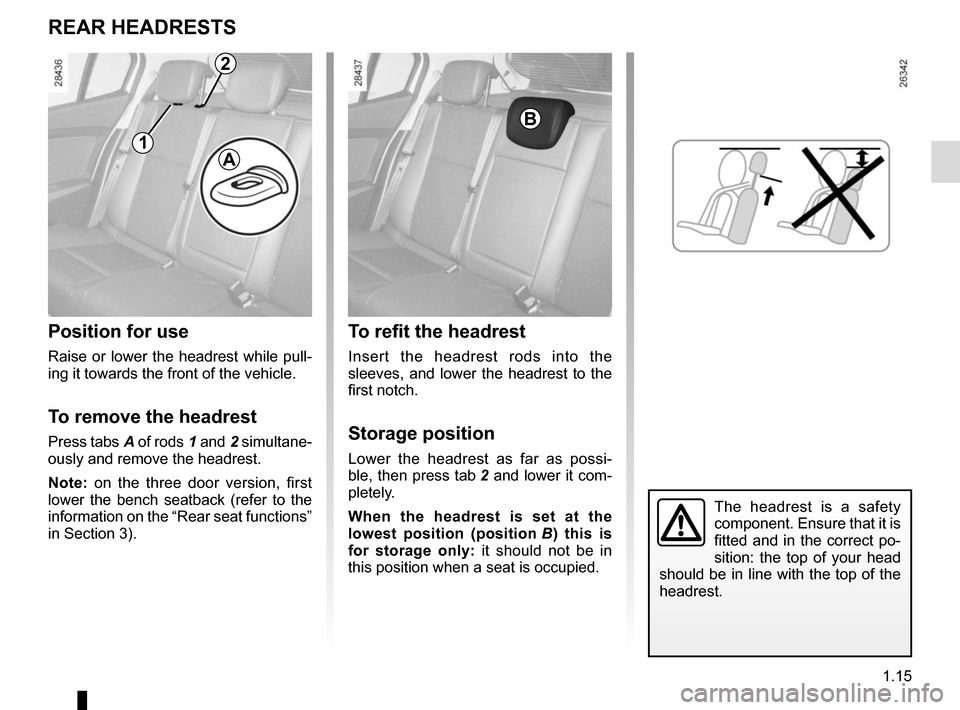
1.15
REAR HEADRESTS
Position for use
Raise or lower the headrest while pull-
ing it towards the front of the vehicle.
To remove the headrest
Press tabs A of rods 1 and 2 simultane-
ously and remove the headrest.
Note: on the three door version, first
lower the bench seatback (refer to the
information on the “Rear seat functions”
in Section 3).
To refit the headrest
Insert the headrest rods into the
sleeves, and lower the headrest to the
first notch.
Storage position
Lower the headrest as far as possi-
ble, then press tab 2 and lower it com-
pletely.
When the headrest is set at the
lowest position (position B ) this is
for storage only: it should not be in
this position when a seat is occupied.
B
1
2
A
The headrest is a safety
component. Ensure that it is
fitted and in the correct po-
sition: the top of your head
should be in line with the top of the
headrest.
Page 22 of 268
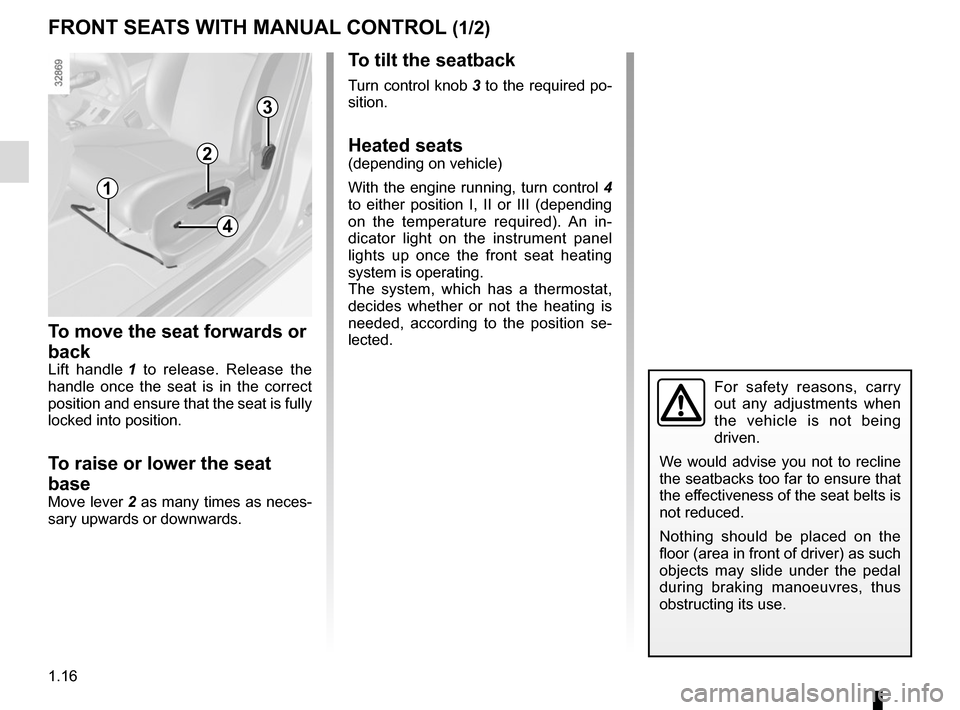
1.16
FRONT SEATS WITH MANUAL CONTROL (1/2)
To move the seat forwards or
back
Lift handle 1 to release. Release the
handle once the seat is in the correct
position and ensure that the seat is fully
locked into position.
To raise or lower the seat
base
Move lever 2 as many times as neces-
sary upwards or downwards.
To tilt the seatback
Turn control knob 3 to the required po-
sition.
Heated seats(depending on vehicle)
With the engine running, turn control 4
to either position I, II or III (depending
on the temperature required). An in-
dicator light on the instrument panel
lights up once the front seat heating
system is operating.
The system, which has a thermostat,
decides whether or not the heating is
needed, according to the position se-
lected.
For safety reasons, carry
out any adjustments when
the vehicle is not being
driven.
We would advise you not to recline
the seatbacks too far to ensure that
the effectiveness of the seat belts is
not reduced.
Nothing should be placed on the
floor (area in front of driver) as such
objects may slide under the pedal
during braking manoeuvres, thus
obstructing its use.
1
2
3
4
Page 23 of 268
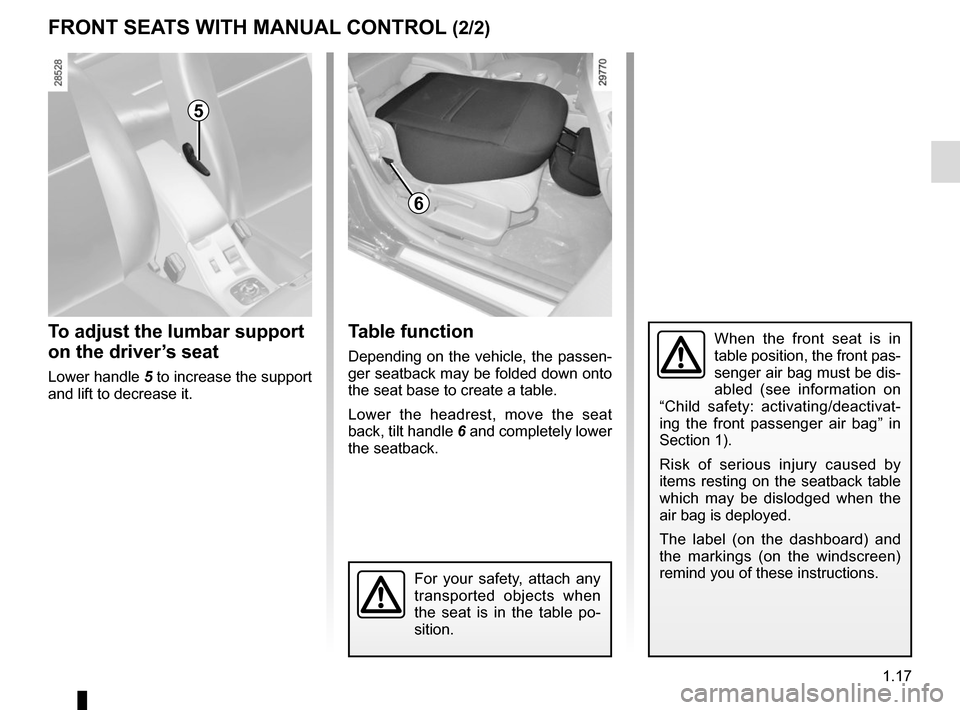
1.17
Table function
Depending on the vehicle, the passen-
ger seatback may be folded down onto
the seat base to create a table.
Lower the headrest, move the seat
back, tilt handle 6 and completely lower
the seatback.
6
For your safety, attach any
transported objects when
the seat is in the table po-
sition.
FRONT SEATS WITH MANUAL CONTROL (2/2)
5
To adjust the lumbar support
on the driver’s seat
Lower handle 5 to increase the support
and lift to decrease it.
When the front seat is in
table position, the front pas-
senger air bag must be dis-
abled (see information on
“Child safety: activating/deactivat-
ing the front passenger air bag” in
Section 1).
Risk of serious injury caused by
items resting on the seatback table
which may be dislodged when the
air bag is deployed.
The label (on the dashboard) and
the markings (on the windscreen)
remind you of these instructions.
Page 24 of 268
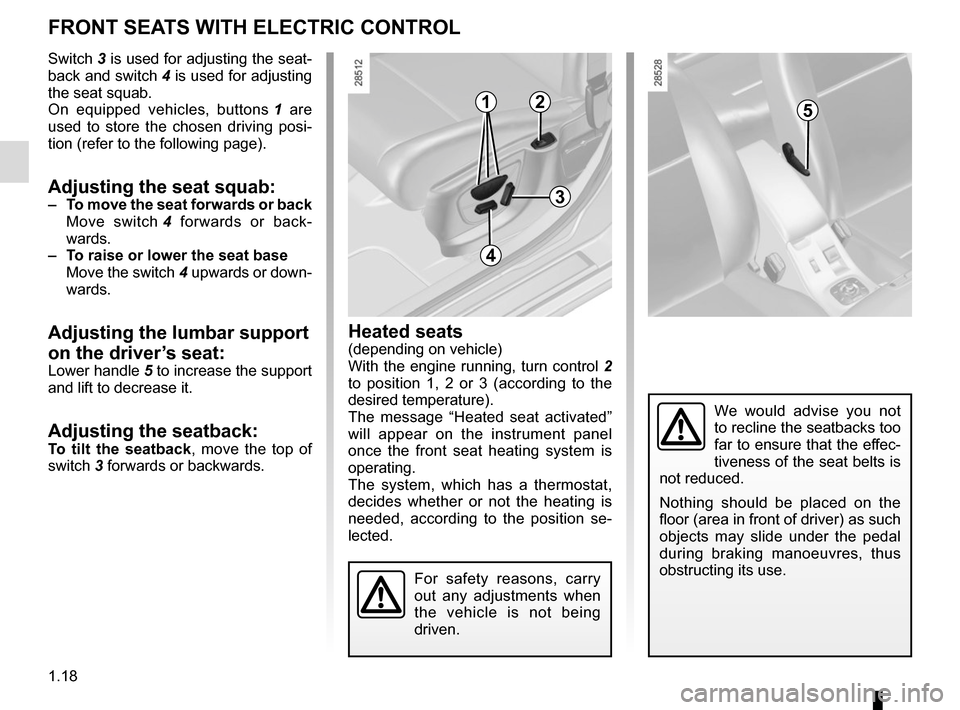
1.18
Heated seats(depending on vehicle)
With the engine running, turn control 2
to position 1, 2 or 3 (according to the
desired temperature).
The message “Heated seat activated”
will appear on the instrument panel
once the front seat heating system is
operating.
The system, which has a thermostat,
decides whether or not the heating is
needed, according to the position se-
lected.
For safety reasons, carry
out any adjustments when
the vehicle is not being
driven.
We would advise you not
to recline the seatbacks too
far to ensure that the effec-
tiveness of the seat belts is
not reduced.
Nothing should be placed on the
floor (area in front of driver) as such
objects may slide under the pedal
during braking manoeuvres, thus
obstructing its use.
Switch 3 is used for adjusting the seat-
back and switch 4 is used for adjusting
the seat squab.
On equipped vehicles, buttons 1 are
used to store the chosen driving posi-
tion (refer to the following page).
Adjusting the seat squab:– To move the seat forwards or back
Move switch 4 forwards or back-
wards.
– To raise or lower the seat base
Move the switch 4 upwards or down-
wards.
Adjusting the lumbar support
on the driver’s seat:
Lower handle 5 to increase the support
and lift to decrease it.
Adjusting the seatback:To tilt the seatback, move the top of
switch 3 forwards or backwards.
FRONT SEATS WITH ELECTRIC CONTROL
2
4
3
15
Page 25 of 268
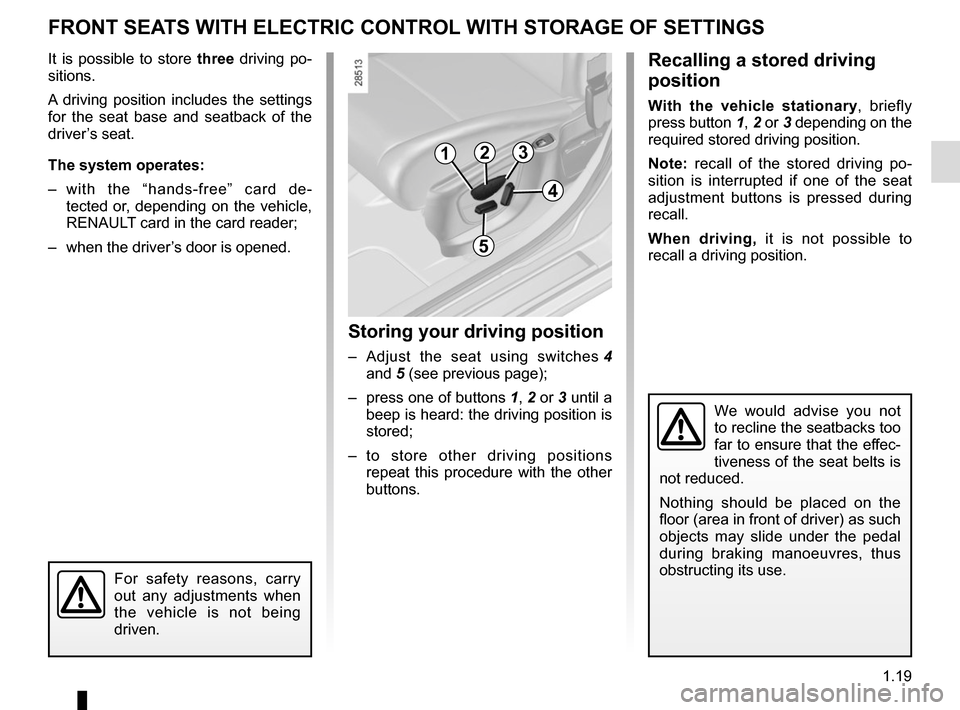
1.19
FRONT SEATS WITH ELECTRIC CONTROL WITH STORAGE OF SETTINGS
It is possible to store three driving po-
sitions.
A driving position includes the settings
for the seat base and seatback of the
driver’s seat.
The system operates:
– with the “hands-free” card de-tected or, depending on the vehicle,
RENAULT card in the card reader;
– when the driver’s door is opened.
Storing your driving position
– Adjust the seat using switches 4
and 5 (see previous page);
– press one of buttons 1, 2 or 3 until a
beep is heard: the driving position is
stored;
– to store other driving positions repeat this procedure with the other
buttons.
Recalling a stored driving
position
With the vehicle stationary, briefly
press button 1, 2 or 3 depending on the
required stored driving position.
Note: recall of the stored driving po-
sition is interrupted if one of the seat
adjustment buttons is pressed during
recall.
When driving, it is not possible to
recall a driving position.
123
4
5
We would advise you not
to recline the seatbacks too
far to ensure that the effec-
tiveness of the seat belts is
not reduced.
Nothing should be placed on the
floor (area in front of driver) as such
objects may slide under the pedal
during braking manoeuvres, thus
obstructing its use.
For safety reasons, carry
out any adjustments when
the vehicle is not being
driven.
Page 26 of 268
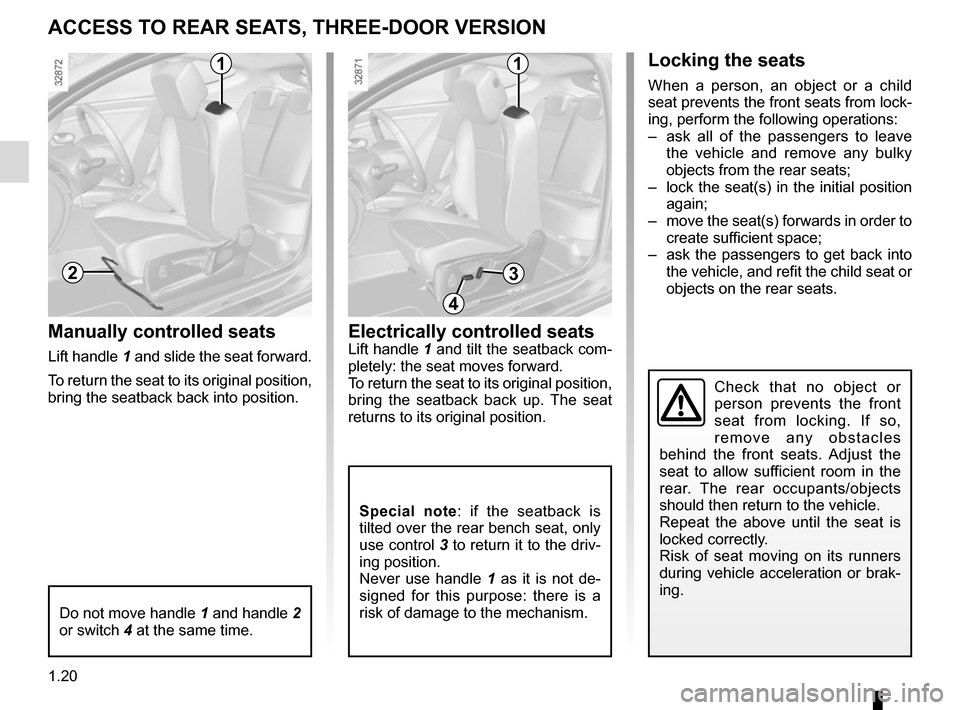
1.20
Electrically controlled seatsLift handle 1 and tilt the seatback com-
pletely: the seat moves forward.
To return the seat to its original position,
bring the seatback back up. The seat
returns to its original position.
ACCESS TO REAR SEATS, THREE-DOOR VERSION
Manually controlled seats
Lift handle 1 and slide the seat forward.
To return the seat to its original position,
bring the seatback back into position.
Check that no object or
person prevents the front
seat from locking. If so,
remove any obstacles
behind the front seats. Adjust the
seat to allow sufficient room in the
rear. The rear occupants/objects
should then return to the vehicle.
Repeat the above until the seat is
locked correctly.
Risk of seat moving on its runners
during vehicle acceleration or brak-
ing.
Do not move handle 1 and handle 2
or switch 4 at the same time.
1
2
Locking the seats
When a person, an object or a child
seat prevents the front seats from lock-
ing, perform the following operations:
– ask all of the passengers to leave the vehicle and remove any bulky
objects from the rear seats;
– lock the seat(s) in the initial position again;
– move the seat(s) forwards in order to create sufficient space;
– ask the passengers to get back into the vehicle, and refit the child seat or
objects on the rear seats.
Special note: if the seatback is
tilted over the rear bench seat, only
use control 3 to return it to the driv-
ing position.
Never use handle 1 as it is not de-
signed for this purpose: there is a
risk of damage to the mechanism.
1
4
3
Page 27 of 268
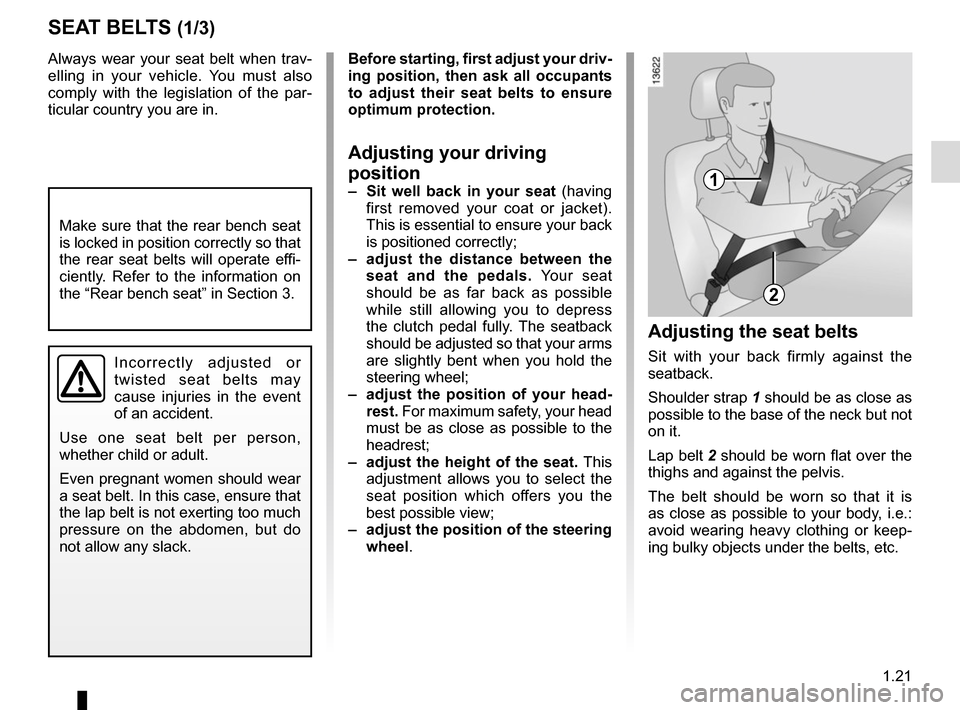
1.21
Always wear your seat belt when trav-
elling in your vehicle. You must also
comply with the legislation of the par-
ticular country you are in.
Incorrectly adjusted or
twisted seat belts may
cause injuries in the event
of an accident.
Use one seat belt per person,
whether child or adult.
Even pregnant women should wear
a seat belt. In this case, ensure that
the lap belt is not exerting too much
pressure on the abdomen, but do
not allow any slack.
Before starting, first adjust your driv-
ing position, then ask all occupants
to adjust their seat belts to ensure
optimum protection.
Adjusting your driving
position
– Sit well back in your seat (having
first removed your coat or jacket).
This is essential to ensure your back
is positioned correctly;
– adjust the distance between the seat and the pedals. Your seat
should be as far back as possible
while still allowing you to depress
the clutch pedal fully. The seatback
should be adjusted so that your arms
are slightly bent when you hold the
steering wheel;
– adjust the position of your head- rest. For maximum safety, your head
must be as close as possible to the
headrest;
– adjust the height of the seat. This
adjustment allows you to select the
seat position which offers you the
best possible view;
– adjust the position of the steering
wheel.
Adjusting the seat belts
Sit with your back firmly against the
seatback.
Shoulder strap 1 should be as close as
possible to the base of the neck but not
on it.
Lap belt 2 should be worn flat over the
thighs and against the pelvis.
The belt should be worn so that it is
as close as possible to your body, i.e.:
avoid wearing heavy clothing or keep-
ing bulky objects under the belts, etc.
SEAT BELTS (1/3)
1
2
Make sure that the rear bench seat
is locked in position correctly so that
the rear seat belts will operate effi-
ciently. Refer to the information on
the “Rear bench seat” in Section 3.
Page 28 of 268
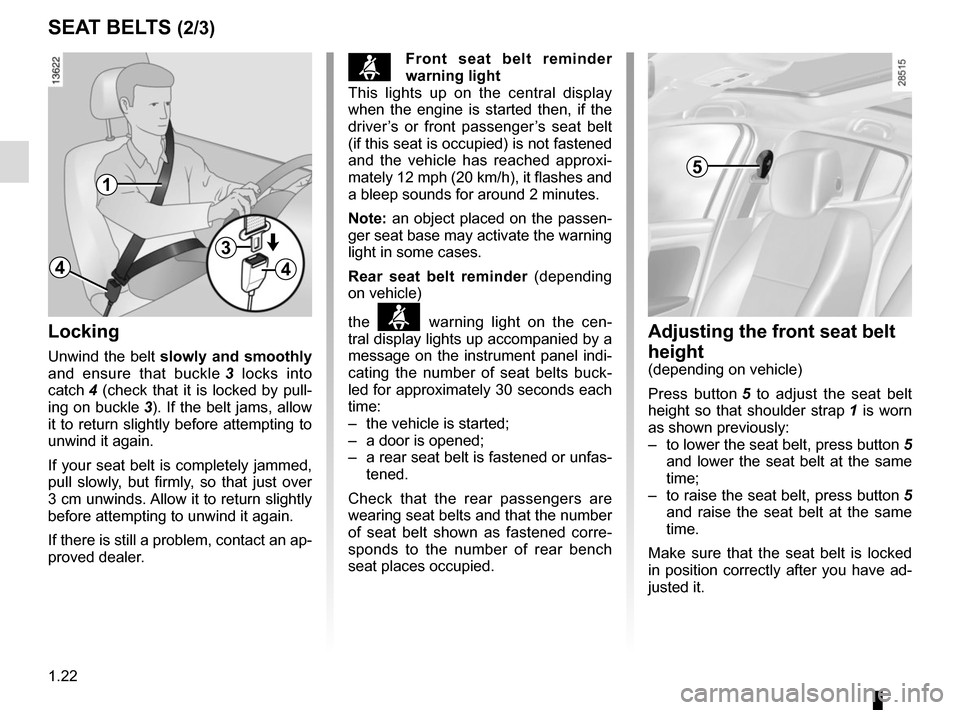
1.22
SEAT BELTS (2/3)Adjusting the front seat belt
height
(depending on vehicle)
Press button 5 to adjust the seat belt
height so that shoulder strap 1 is worn
as shown previously:
– to lower the seat belt, press button 5
and lower the seat belt at the same
time;
– to raise the seat belt, press button 5
and raise the seat belt at the same
time.
Make sure that the seat belt is locked
in position correctly after you have ad-
justed it.
5
Locking
Unwind the belt slowly and smoothly
and ensure that buckle 3 locks into
catch 4 (check that it is locked by pull- ing on buckle 3). If the belt jams, allow
it to return slightly before attempting to
unwind it again.
If your seat belt is completely jammed,
pull slowly, but firmly, so that just over
3 cm unwinds. Allow it to return slightly
before attempting to unwind it again.
If there is still a problem, contact an ap-
proved dealer.
1
4
3
4
ßFront seat belt reminder
warning light
This lights up on the central display
when the engine is started then, if the
driver’s or front passenger’s seat belt
(if this seat is occupied) is not fastened
and the vehicle has reached approxi-
mately 12 mph (20 km/h), it flashes and
a bleep sounds for around 2 minutes.
Note: an object placed on the passen-
ger seat base may activate the warning
light in some cases.
Rear seat belt reminder (depending
on vehicle)
the
ß warning light on the cen-
tral display lights up accompanied by a
message on the instrument panel indi-
cating the number of seat belts buck-
led for approximately 30 seconds each
time:
– the vehicle is started;
– a door is opened;
– a rear seat belt is fastened or unfas- tened.
Check that the rear passengers are
wearing seat belts and that the number
of seat belt shown as fastened corre-
sponds to the number of rear bench
seat places occupied.
Page 29 of 268
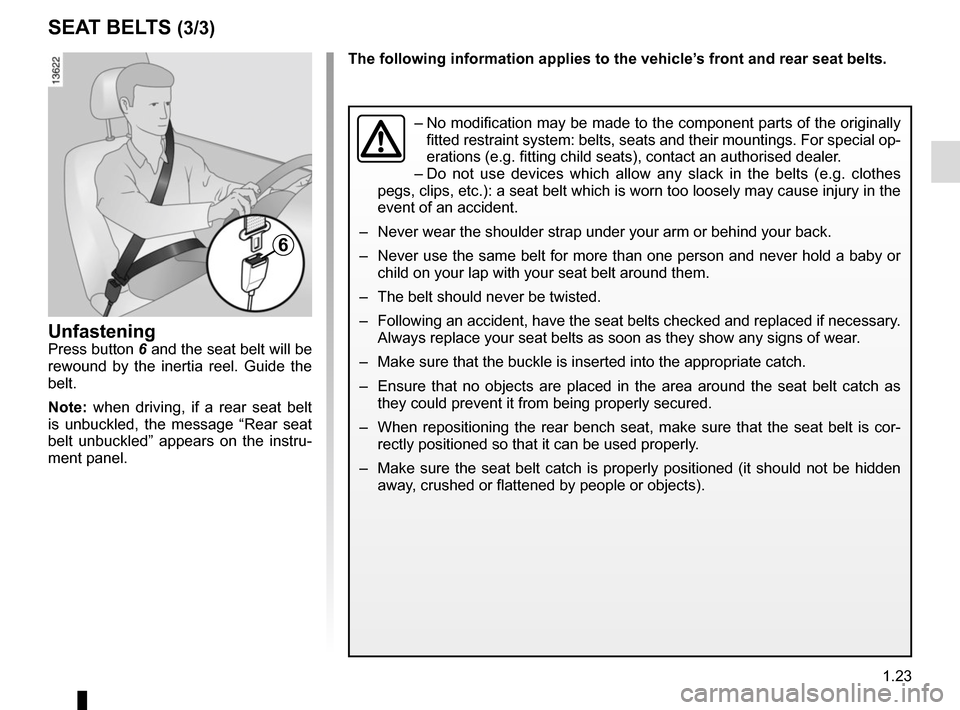
1.23
SEAT BELTS (3/3)
The following information applies to the vehicle’s front and rear seat belts.
UnfasteningPress button 6 and the seat belt will be
rewound by the inertia reel. Guide the
belt.
Note: when driving, if a rear seat belt
is unbuckled, the message “Rear seat
belt unbuckled” appears on the instru-
ment panel.
6
– No modification may be made to the component parts of the originally
fitted restraint system: belts, seats and their mountings. For special o\
p-
erations (e.g. fitting child seats), contact an authorised dealer.
– Do not use devices which allow any slack in the belts (e.g. clothes
pegs, clips, etc.): a seat belt which is worn too loosely may cause inj\
ury in the
event of an accident.
– Never wear the shoulder strap under your arm or behind your back.
– Never use the same belt for more than one person and never hold a baby o\
r child on your lap with your seat belt around them.
– The belt should never be twisted.
– Following an accident, have the seat belts checked and replaced if neces\
sary. Always replace your seat belts as soon as they show any signs of wear.
– Make sure that the buckle is inserted into the appropriate catch.
– Ensure that no objects are placed in the area around the seat belt catch\
as they could prevent it from being properly secured.
– When repositioning the rear bench seat, make sure that the seat belt is \
cor- rectly positioned so that it can be used properly.
– Make sure the seat belt catch is properly positioned (it should not be \
hidden away, crushed or flattened by people or objects).
Page 30 of 268
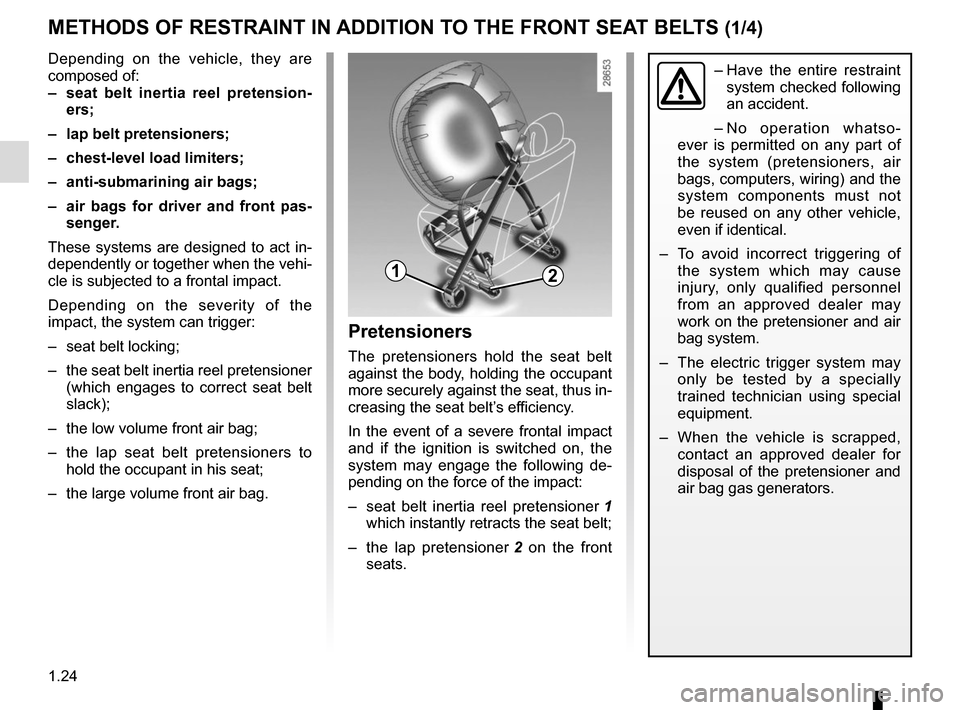
1.24
METHODS OF RESTRAINT IN ADDITION TO THE FRONT SEAT BELTS (1/4)
Depending on the vehicle, they are
composed of:
– seat belt inertia reel pretension-ers;
– lap belt pretensioners;
– chest-level load limiters;
– anti-submarining air bags;
– air bags for driver and front pas- senger.
These systems are designed to act in-
dependently or together when the vehi-
cle is subjected to a frontal impact.
Depending on the severity of the
impact, the system can trigger:
– seat belt locking;
– the seat belt inertia reel pretensioner (which engages to correct seat belt
slack);
– the low volume front air bag;
– the lap seat belt pretensioners to hold the occupant in his seat;
– the large volume front air bag.
Pretensioners
The pretensioners hold the seat belt
against the body, holding the occupant
more securely against the seat, thus in-
creasing the seat belt’s efficiency.
In the event of a severe frontal impact
and if the ignition is switched on, the
system may engage the following de-
pending on the force of the impact:
– seat belt inertia reel pretensioner 1
which instantly retracts the seat belt;
– the lap pretensioner 2 on the front
seats.
– Have the entire restraint
system checked following
an accident.
– No operation whatso-
ever is permitted on any part of
the system (pretensioners, air
bags, computers, wiring) and the
system components must not
be reused on any other vehicle,
even if identical.
– To avoid incorrect triggering of the system which may cause
injury, only qualified personnel
from an approved dealer may
work on the pretensioner and air
bag system.
– The electric trigger system may only be tested by a specially
trained technician using special
equipment.
– When the vehicle is scrapped, contact an approved dealer for
disposal of the pretensioner and
air bag gas generators.
12